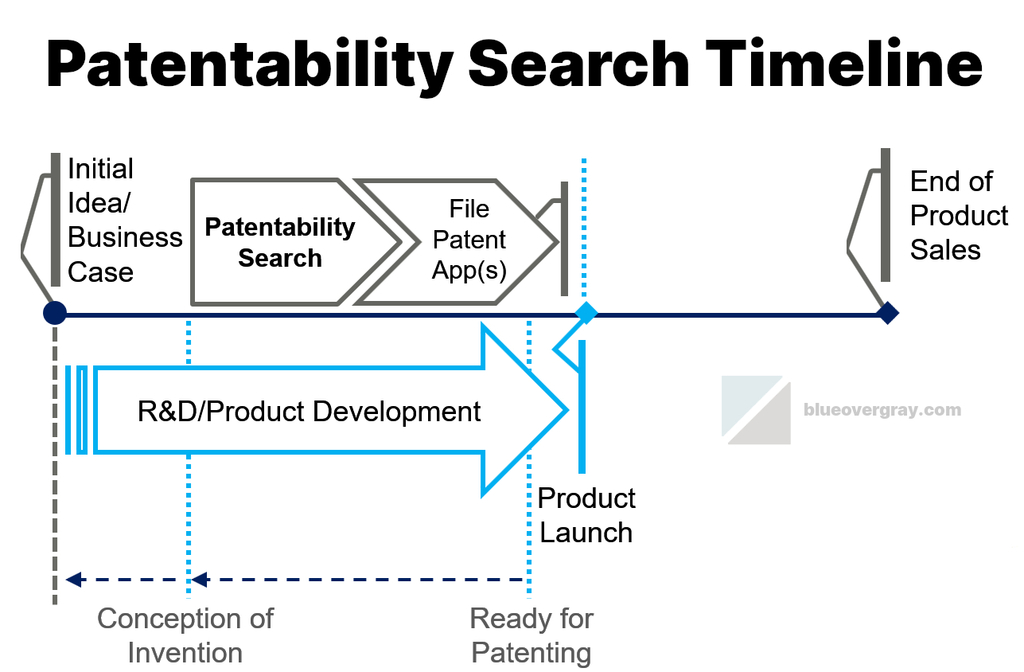A full assessment of patentability requires identifying the closest prior art and then performing a legal analysis of the invention you want to patent in light of that prior art. Doing this meaningfully requires a patentability search. You need to conduct a patentability search at the right time to get the most value from it. An example timeline for a patentability search is shown below. This example timeline is meant to illustrate best practices for timing a patentability search in relation to filing a new patent application.

You start with an initial idea or business case. That is the point at which there is a commitment to spend time and resources to try to come up with an invention. But it may be no more than a wish or plan. Sometime after that research & development (R&D) and product development begins. And at some point one or more inventions are conceived. That might occur at the same time as the initial idea or closely following it. Or there might be considerable R&D and development work needed before it appears that an actual invention has been conceived.
The invention is ready for patenting when it is possible to document how to make and use it. This might happen at the same time as conception. Or an invention might start as a loose collection of disjointed thoughts in the inventor’s mind and require extensive experimental testing before before the details can be meaningfully documented. Building a working prototype is sufficient but not required. Sometimes you might just want to test different embodiments to determine which is most viable. What matters most is that an invention must be sufficiently developed beyond a mere wish or plan to invent before a patent application can be prepared. But the applicant also has to subjectively feel ready to move forward with patenting a particular invention too.
Ideally, a patent application should be filed before any public disclosure, public use, or commercialization of the invention. This is required in many countries. Though there is a one-year grace period for patent filings in the United States after a public disclosure or sale by the inventor.
The patentability search should ideally be conducted before patent application drafting begins. This allows the results of the patentability search to be fully taken into account while preparing the application. It is often possible to write a better patent application when the closest prior art is known. Differences and improvements over the prior art can be described more thoroughly that way. Also, if the patentability search is unfavorable then you can avoid the expense of preparing and filing a patent application. That is one of the best reasons to perform a search.
It is possible to perform a patentability search while a patent application is being prepared. But once application drafting has begun it gets progressively harder to incorporate search results. And once a non-provisional application is filed the benefits of a patentability search drop close to zero. Though searches are still beneficial when done between the filing of a provisional patent application and the preparation of a non-provisional application.
But a particular invention must already be conceived before the patentability search is performed. If you don’t have any idea what the invention actually is, you cannot perform a meaningful patentability search. Otherwise you wouldn’t know what to search for. These searches are directly tied to the invention you want to patent after all. If you haven’t actually conceived an invention yet and just want to evaluate business opportunities (rather than patentability) then a landscape search is more appropriate.
In some circumstances, you may wish to delay a patentability search. That can help avoid wasted search effort if other inventions might take precedence in business plans. But, on the other hand, a patentability search might help you determine if an invention is ready and worthy of patenting. Applicants have wide latitude to define their inventions however they want. Sometimes you start with a broad view of an invention but a patentability search reveals that some aspects were actually already known. You might then have to do further development in order for the most promising “new” aspects to be ready for patenting. Or you might find that the patentable aspects are simply not commercially valuable enough to pursue.
You might also combine a patentability search with a freedom-to-operate (FTO) search. FTO searches assess risks of infringement for a planned product or service. The timing has to be right for both types of searches for a combined study to make sense. The parameters and legal considerations for patentability and FTO studies also differ significantly. So a combined search always involves more effort than one search individually. But sometimes there is enough overlap in the searching effort for a combined search to make sense.

Austen Zuege is an attorney at law and registered U.S. patent attorney in Minneapolis whose practice encompasses patents, trademarks, copyrights, domain name cybersquatting, IP agreements and licensing, freedom-to-operate studies, client counseling, and IP litigation. If you have patent, trademark, or other IP issues, he can help.
